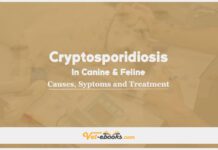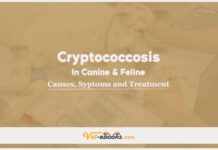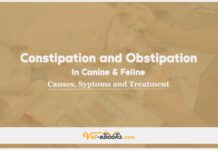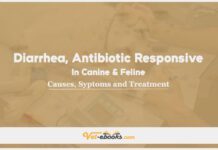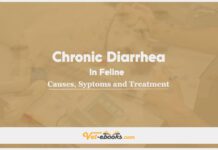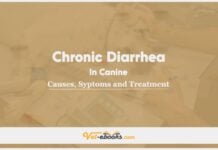Bilious Vomiting Syndrome In Canine and Feline: Causes, Symptoms and Treatment
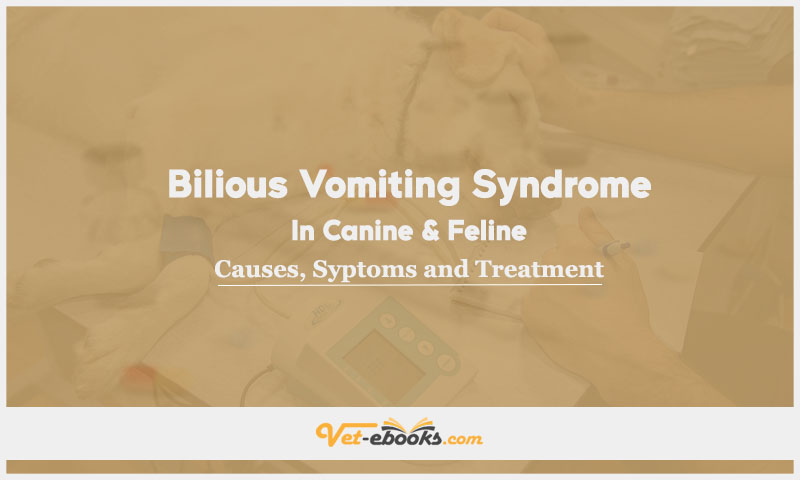
Contents
hide
Overview
- Bilious Vomiting Syndrome (BVS) is a persistent intermittent vomiting, which is believed to be caused by the backflow of intestinal contents, specifically bile, into the stomach.
- Clinical manifestations frequently manifest in the early hours of the day, implying that extended periods of fasting or reduced stomach activity may alter the typical patterns of gastrointestinal movement, leading to the occurrence of bile reflux.
Causes of Bilious Vomiting Syndrome In Canine and Feline
Causes and Risk factors
- The etiology of this condition is unknown, (idiopathic).
- It is believed that primary gastric hypomotility or aberrant intestinal peristaltic motility may be the likely underlying causes.
- Conditions that result in gastritis, duodenitis, or intestinal obstructive disease have the potential to disrupt the normal motility of the proximal gastrointestinal tract, leading to bile reflux.
- It is recommended to explore the possibility of parasitism (such as Giardia infection), inflammatory bowel disease (IBD), intestinal neoplasia, or obstructions as potential causes for these conditions.
Pathogenesis of Bilious Vomiting Syndrome In Canine and Feline
- The normal functioning of gastric and intestinal motility, in addition to a functional gastric pylorus, serves to prevent the occurrence of duodenogastric reflux, which involves the backward flow of bile and other contents from the duodenum into the stomach.
- When bile is regurgitated into the stomach, it is typically expeditiously eliminated through consecutive aborad peristaltic contractions of the stomach wall.
- The coexistence of bile, gastric acid, and pepsin in the gastric lumen lead to irritation, impairment of the gastric mucosal barrier, injury, and inflammation.
- These effects have a negative impact on gastric motility.
- The suspected cause of bilious vomiting syndrome is believed to be related to changes in gastrointestinal motility, specifically the giant migrating motor complexes (MMC) that occur during the interdigestive phase.
- These changes result in the stomach being unable to maintain a higher intragastric pressure compared to the pressure in the duodenum.
- The clinical symptoms typically manifests in the early morning or when the stomach is empty, indicating that extended periods of fasting or reduced gastric activity may alter the regular patterns of movement, leading to the backflow of bile from the duodenum to the stomach, known as duodenogastric reflux.
Symptoms (History & Physical Examination) of Bilious Vomiting Syndrome In Canine and Feline
History
- The presence of chronic intermittent vomiting of bile is often observed in individuals who experience episodes of vomiting when their stomach is empty.
- Signs typically manifest during the late hours of the night or the early hours of the morning.
- Signs may manifest on a daily basis, albeit typically in an intermittent manner.
- In the interim periods, the animal exhibits typical behavior and most canines display signs of good health soon following episodes of vomiting.
Physical Examination
The findings of the physical examination often reveal no notable abnormalities.
Diagnosis of Bilious Vomiting Syndrome In Canine and Feline
1- From History and Physical Examination
2- Diagnostic Procedures
CBC/BIOCHEMISTRY/URINALYSIS
The outcomes typically lack notable characteristics, although they hold significance in the process of eliminating alternative explanations, such as metabolic factors, for chronic vomiting.
OTHER LABORATORY TESTS
- To exclude the possibility of atypical hypoadrenocorticism, it is recommended to do a baseline cortisol test and, if necessary, an adrenocorticotropic hormone (ACTH) stimulation test.
- The measurement and interpretation of serum specific canine pancreatic lipase (Spec cPL) should be conducted in conjunction with diagnostic imaging findings in order to assess the patient for potential pancreatitis.
- Fecal direct inspection and flotation are recommended procedures for the detection of endoparasites.
- The presence of Giardia species can be identified using an antigen enzyme-linked immunosorbent test (ELISA).
Imaging:
- Abdominal ultrasonography and thoracic radiographs typically exhibit no significant findings; however, they play a crucial role in excluding alternative diagnosis or problems associated with recurrent vomiting, such as aspiration pneumonia.
- A barium contrast examination has the potential to detect delayed stomach emptying, which typically takes 6-8 hours in dogs and 4-6 hours in cats.
- It is important to exercise caution when interpreting these findings inside a hospital environment.
- In the context of a comparative analysis, barium can be administered in conjunction with meals or in the form of radiopaque markers, specifically barium-impregnated polyethylene spheres (BIPS).
- Gastric emptying ultrasonography, involving the continuous assessment of the cross-sectional area or estimated volume of the pyloric antrum, or the utilization of a specialized noninvasive wireless motility capsule system (known as SmartpillTM), capable of detecting pH, temperature, and pressure/contractions, can be employed to ascertain instances of delayed gastric motility (Figure 50.1).
- Additional procedures that can be considered, although they may have limited practicality, are 99mTc‐radioscintigraphy and 13C‐sodium acetate breath testing.
3- Differential Diagnosis
- Chronic vomiting can be attributed to a variety of gastrointestinal (GI) and non-GI illnesses.
- The exclusion of Giardia is warranted due to the potential for its symptoms to resemble those of Bovine Viral Scourge (BVS).
- Inflammatory bowel disease (IBD) has the potential to lead to the occurrence of bile reflux.
- It is imperative to consider the possibility of intestinal obstruction or partial obstructions.
Treatment of Bilious Vomiting Syndrome In Canine and Feline
General
- In the event that dietary adjustment is ineffective, it is advisable to explore medical therapy alternatives.
- The available pharmacological options encompass substances that can provide protection to the gastric mucosa against bile reflux, as well as gastric prokinetic medicines that can enhance gastric motility.
- In many cases, the administration of a solitary dose of medication in the evening may enough to mitigate the manifestation of clinical symptoms, particularly if these symptoms manifest during nighttime or early morning hours.
- In an alternative approach, the administration of the prokinetic agent might be conducted 30 minutes prior to the initiation of feeding.
Medications:
- Two specific gastric prokinetic drugs that can be used are metoclopramide as a D2 ‐receptor antagonist (at a dose of 0.2–0.4 mg/kg PO q6–8h or 0.01–0.02 mg/kg/h IV as a CRI) and cisapride as a 5‐HT4 ‐receptor agonist (at a dose of 0.2–0.5 mg/kg q8–12h PO).
- Erythromycin as a motilin‐receptor agonist (at a dose of 0.5–1 mg/kg q8–12h IV).
- Ranitidine (at a dose of 1–2 mg/kg q8–12h PO or IV) or famotidine (at a dose of 0.5–1 mg/kg q12h PO or IV) are H2‐receptor antagonists (H2RA) to decrease the production of stomach acid.
- Omeprazole (at a dose of 0.7–1 mg/kg q12–24h PO), esomeprazole ( at a dose of 0.5–1 mg/kg q24h PO or IV) and pantoprazole (at a dose of 0.7–1 mg/kg q24h IV (give over ≥15 min)) are Proton pump inhibitors (PPI) to decrease the production of stomach acid.
- Sucralfate (at a dose of 20–40 mg/kg q6–8h PO or 0.5–1.0 g q6–8h PO) is direct cytoprotectant and Antacids such as Aluminium hydroxide (at a dose of 100–200 mg q4–6h PO in dogs or 50–100 mg q4–6h PO in cats) and Magnesium hydroxide (at a dose of 5–15 ml q12–24h PO) to protect the gastric mucosa.
- Empirical deworming, specifically the administration of fenbendazole (at a dose of 50mg/kg orally every 24 hours) for a duration of 3 to 5 days.
Some Notes:
- Gastric prokinetic drugs are contraindicated in patients with gastrointestinal blockage.
- Metoclopramide induce symptoms of agitation, anxiety, or sadness.
- Cisapride may induce adverse effects such as emesis, diarrhea, or abdominal spasms when administered at elevated dosages.
- Esophagitis may arise as a consequence of persistent emesis.
Tip
Do You Want To Increase Your Veterinary Knowledge and Practical Skills?
You Can Now Browse and Download +3000 Books For Veterinary Professionals & Students Online.
Download Veterinary Books

